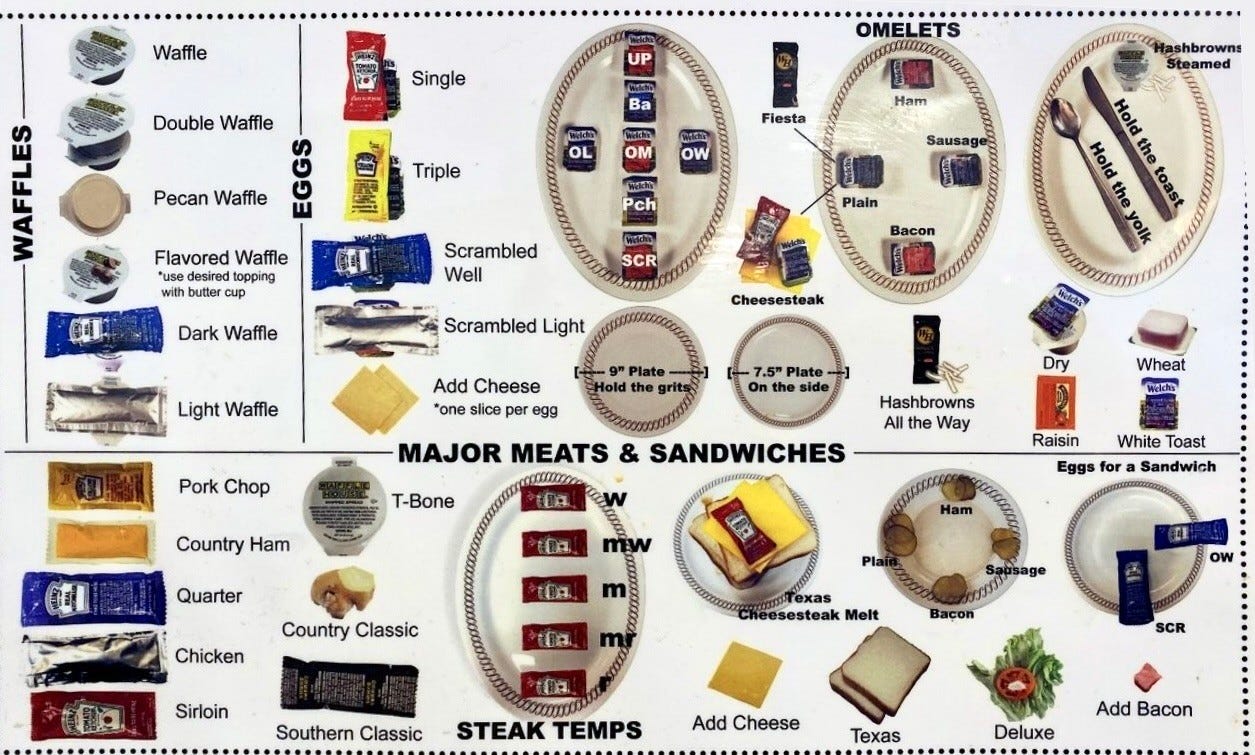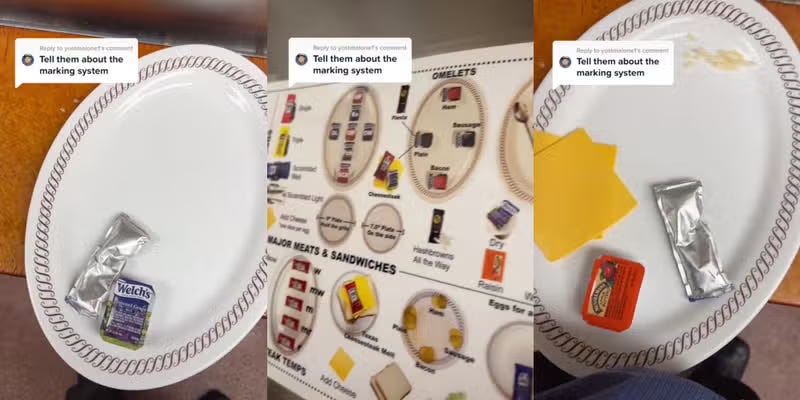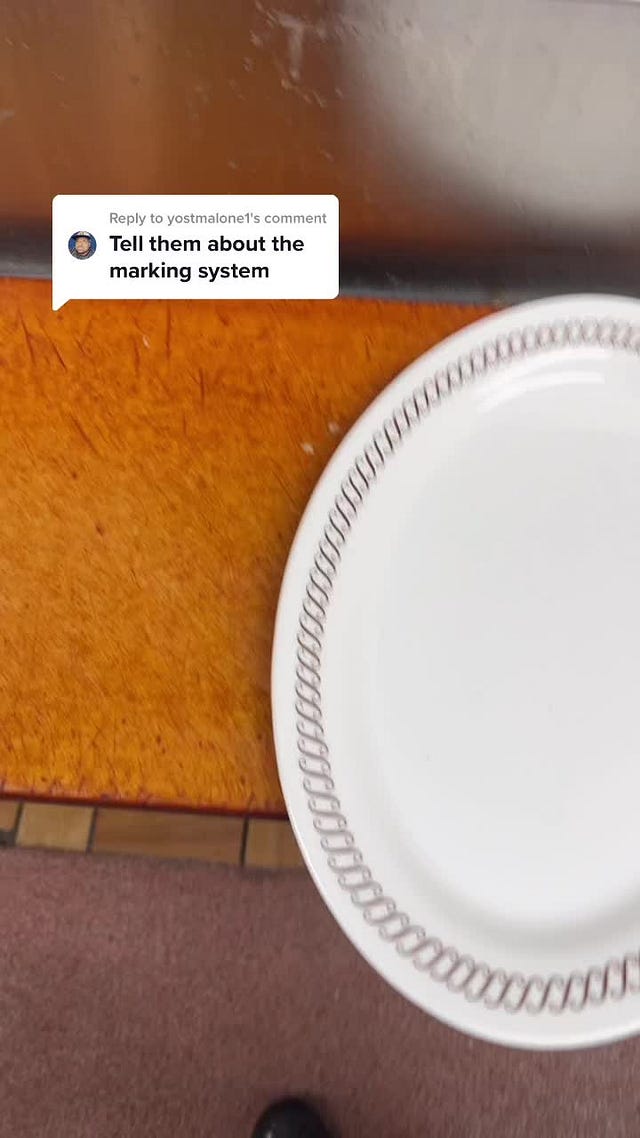I love working on systems; it’s why I keep working on the internal tooling side of engineering orgs. There are unlimited tweaks you can make, and your primary customer is one Slack huddle away. This week, I found a new system that seems insane and is one of the more unique systems I think I’ve ever come across. That system is the Magic Marker system from Waffle House.
Waffle House somehow managed to create a universal menu language from scratch, using only the items in their restaurants. They’re using the system to make sure everybody is on the same page, everybody understands the same system across all of their locations, and even in the chaos of a bustling restaurant, they can flawlessly keep orders coming out of the kitchen.
No tickets needed, no deciphering speedy scrawls, pure efficiency. Waffle House has hundreds of locations in the U.S., and every single one follows the same system.
I’ll give you the short version because again, even I don’t fully understand exactly what’s happening. The Magic Marker system at Waffle House is about teeing up an order by arranging items on a plate like some sort of Guy Fieri fryomancer.
You place items (like jelly packets) on the plate to then indicate “here is what I need you to cook and how”, all the way down to how eggs are prepared (scrambled, over easy, over hard, etc). The placement of an item on the plate dictates how those eggs or that item will be cooked. It’s pretty ingenious, and seems a little insane (as with most great ideas).
Here’s the training video for the system, and a quote pull to give you a sense of what we’re dealing with.
Cheese omelet or a mushroom omelet: these are marked using a horizontal jelly packet in the number four position and a piece of the corresponding ingredient. Here you can see a cheese omelet also the Fiesta omelet which is indicated by a horizontal jelly pack with a right side up salad dressing.
If that sounds like nonsense, you’re right, but that’s also because you haven’t been onboarded appropriately.
Unwritten Rules
There are a lot of unwritten rules and micro-habits in organizations. I’ve recently gotten to onboard a few engineers at Trellis, and it’s interesting to try to figure out what all of those unwritten rules are and if we’ve appropriately written them down, or codified them. How do we create our own Magic Marker system so that new folks can learn quickly and slot right in within the team?
Especially in startups, you grow your teams because you are feeling the strain of too many problems, not enough people. As soon as someone walks in the door, you want to hand them a problem to begin reducing risk. Waffle House reminds us that while you may want to get your new hire involved right away, you have to teach them the system first.
We have language, but I think the beauty of this system, and the beauty of some of these more bespoke rules, are that it surpasses that. It gives you a quick chance to review and visually understand what something means. Think of this as architecture diagrams, or Loom walkthroughs showing every step in the path of your system, connecting the concept, the visual element, the code itself, and the data.
Other things to note are the visual queues a new hire is likely to see. We use 👀 reactjis in Slack to show we’ve seen something. Some orgs it ends there, but we know we mean “I’ve seen it and am taking action.” If there is both a 👀 reactji and a ✅ reactji, it means I’ve seen this, and we’re good to go. Even then we’ll usually add some notes with proof of why we’re good to go.
Consider how you’re arranging the plates at work and be sure to jot down the system so others can easily review and adapt.
Regardless of how bizarre the system seems, you have to write it down and you have to be able to get that information out and understandable to other people that will join your organization. Instead of having different words for things, a symbol can sometimes be enough.
System Flexibility
Similar to the systems and rules that we build for both organizations and in software, the system also has to be flexible in case something changes in the future.
Think about current state of Waffle House. I’m no Waffle House expert, but the menu probably hasn’t changed much across its existence. Once you have the menu, it’s pretty set. In a fairly unchanging system, the Magic Marker method works great. But what if Waffle House added 18 new menu items. Could the current system handle the items? What would break?
Thankfully for Waffle House, their system creators were savants and each item has multiple dimensions, with different meanings for upside down, rotated horizontally, vertically, or diagonally, and stacked on top of each other. The system is flexible
Reactjis give a similar flexibility, especially because you can add more to your Slack workspace without issue. As the system evolves, so to will the documents that highlight that evolution. Your system won’t be perfect on the first go, nor should it be. I follow the “aim small, miss small,” method of people systems which lets you reap rewards without major change management overhead.
Try something new out this week, look at your communication channels and see where items are dropping. Is there a visual signal you can add that helps your team know immediately what to do with that item? It might not be as efficient as upside down butter on a plate, but we all have to start somewhere.
I’ll leave you with one more, because I’m still amazed and horrified.
Butter next to a jelly packet = biscuit
Helpful Links
Engineering Leadership & Management
Why Great Engineering Managers Shouldn’t Code
You might think coding makes you a great manager, but think again. This article slices through the myth that hands-on programming is the key for leaders. Instead, discover how empowering your team and focusing on strategy can turbocharge results and drive success.Clarity
Stop the chaos and create laser focus in your team. This article dives into how leaders can strip away confusion, foster clear communication, and energize decision-making. By mastering clarity, you turbocharge team productivity without the burnout.High-Performance Teams That Scale
Unleash the power of high-performing teams. This book dives into strategies for creating clarity, minimizing decision chaos, and safeguarding focused work periods. You will discover actionable insights that elevate your team’s productivity and morale, helping you lead with purpose and impact.Small Teams, Big Results
Small teams can pack a punch when managed right. This article reveals how to harness streamlined decision-making and unshakeable focus to maximize impact. You don’t need a big crew to drive innovation; you need the right mindset and tactics.What happens when we eliminate the Agile leader
Ditching the Agile leader might sound radical, but it could be your secret sauce to unleash team potential. This article dives into how self-managing teams can drive productivity and creativity without traditional hierarchy. If you’re ready to shake things up, this is your roadmap to a leaner, more dynamic workflow.
Remote Work & Organizational Systems
Remote Work Makes Employees Happier: 4-Year Study Confirms
Put a smile on your face. This study reveals that remote work boosts employee happiness, and it’s not just a fling. Engagement rises and burnout dips when teams embrace flexibility. You won’t want to ignore this trend as you shape your organizational culture.Become an Octopus Organization
Ready to transform your organization? This article dives into the dynamic structure of octopus organizations where flexibility and interconnectedness reign. You’ll learn how to build resilience and adaptability in your teams to thrive in complex environments.A One-Pager Is All You Need
Cut the clutter and elevate your team’s focus with a killer one-pager. This article reveals how distilling your project goals into a single page can enhance clarity, streamline communication, and drive faster decision-making. You’ll supercharge your team’s effectiveness without the overwhelm.The Full Catalogue
Get ready to feast on a banquet of insights that will nourish your leadership style. This post serves up a comprehensive list of resources that elevate your understanding of organizational dynamics. You’ll transform your team’s performance with actionable strategies that stick.
AI in Engineering Workflows
Why AI Can’t Do Hiring
Hiring with AI? Forget it. This article lays out the critical human elements AI just can’t grasp in the recruitment process. You need nuance, judgment, and gut feel to build a killer team that thrives.Not Artificial, Not Intelligent
Are you tired of buzzwords? This book dives deep into the messy truth about AI, distinguishing hype from reality. It provides actionable insights on how to harness technology effectively without falling for empty promises. Get ready to sharpen your engineering strategies and boost productivity.What most companies overlook when determining AI readiness
AI isn’t just a shiny new toy. You need to dig deep, assessing not just technology but culture, skills, and strategy. Get ready to transform your mindset or risk getting left behind in the data dust.
Prioritization, Strategy & Metrics
Vibe Engineering
In the fast-paced world of tech, vibe engineering is your secret sauce for building high-performance teams. This article dives into creating an environment where people thrive, making collaboration seamless and focused. You will learn how to harness positive energy to supercharge your team’s productivity.Context Switching: The Hidden Productivity Killer
You think multitasking is the secret sauce to productivity? Think again. Context switching steals focus and zaps energy. Learn how to streamline your workflow and reclaim your time for deeper focus and better results.Leadership Unblocked: How to Harness Your Beliefs and Potential
Are your beliefs blocking your team’s potential? This book dives deep into the psychology of leadership, equipping you with powerful strategies to overcome mental roadblocks and elevate your leadership game. Get ready to unleash your team’s true capabilities and foster an environment where innovation thrives.
Broader Industry & Thought Leadership
Respect at Work Returns to Record Low
Attention leaders: workplace respect is hitting rock bottom. This article reveals staggering declines in employee engagement and outlines actionable steps to regain trust and respect. Don’t just serve another bland dish of policies—bring the heat and authenticity back to your culture.RDEL 113: What Are the Seven Team Behaviors That Build Belonging?
Get ready to revolutionize your team dynamics. This article dives into the seven essential behaviors that foster belonging and improve collaboration. Unlock the secret sauce to a thriving work culture and maximize your team’s potential.An engineer’s guide to cultivating belonging in tech
Belonging is not just a buzzword, it’s the secret sauce for team success. This guide dishes out actionable insights on how you can foster an inclusive environment, driving productivity and creativity. If you want to build a team that thrives, you need to read this.I Tried to Quit My Job by Faking a Health Crisis
If you’re feeling burnt out or stuck, this article dives into the wild world of work-life balance struggles. It’s an honest look at the extremes people will reach when their jobs turn toxic. Take a hard look at your own environment and consider what change is truly needed.





